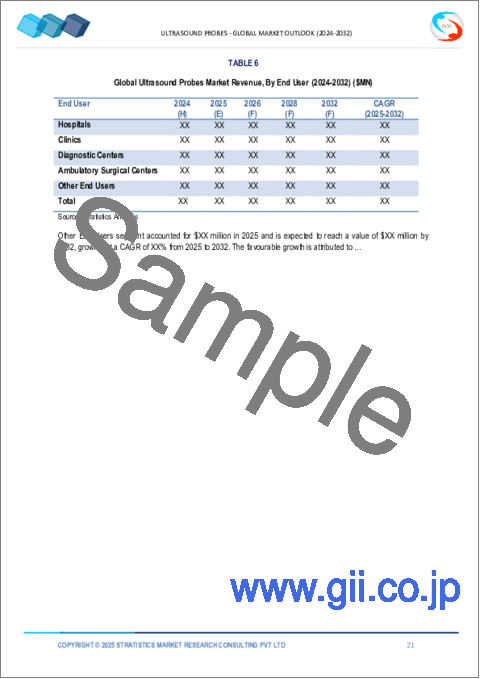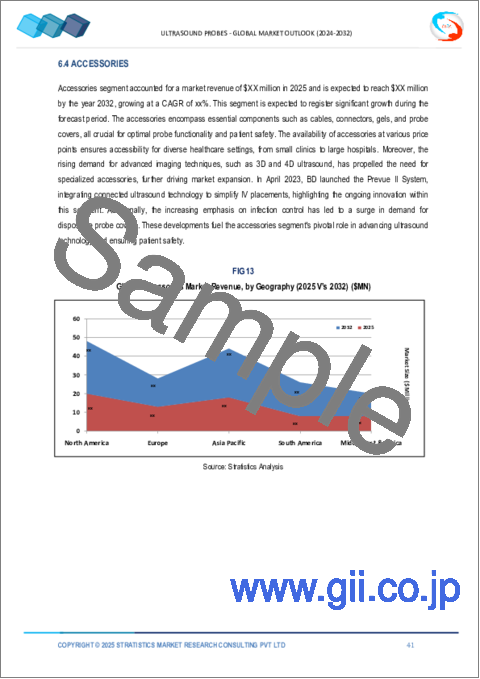|
|
市場調査レポート
商品コード
1511298
超音波プローブの世界市場、2030年までの予測:製品タイプ別、タイプ別、年齢層別、販売チャネル別、用途別、エンドユーザー別、地域別Ultrasound Probes Market Forecasts to 2030 - Global Analysis By Product Type, Type, Age Group, Sales Channel, Application, End User and by Geography |
||||||
カスタマイズ可能
|
|||||||
| 超音波プローブの世界市場、2030年までの予測:製品タイプ別、タイプ別、年齢層別、販売チャネル別、用途別、エンドユーザー別、地域別 |
|
出版日: 2024年07月06日
発行: Stratistics Market Research Consulting
ページ情報: 英文 200+ Pages
納期: 2~3営業日
|
全表示
- 概要
- 図表
- 目次
Stratistics MRCによると、世界の超音波プローブ市場は2024年に39億1,000万米ドルを占め、予測期間中のCAGRは5.70%で成長し、2030年には54億5,000万米ドルに達する見込みです。
トランスデューサー(超音波プローブ)は、超音波イメージングシステムの重要な部品です。電気エネルギーを音波に変換したり、逆に音波を電気エネルギーに変換したりすることで、これらの機器は身体構造の内部を見ることを可能にします。高周波の音波はプローブから発せられ、体内の臓器や組織に跳ね返る。さらに、プローブはこのエコーを拾い上げ、電気信号に変換し、それを処理して精細な画像を生成します。超音波プローブにはさまざまなサイズや形状のものがあり、それぞれ血管、心臓、腹部など特定の用途向けに設計されています。
米国心臓協会によると、心血管疾患の予防には健康的な食生活の維持と定期的な運動が重要です。
低侵襲技術への要求の高まり
世界の動向として、低侵襲手技は従来の手術方法よりも回復期間が短く、合併症が少なく、患者の転帰が良好であることから、低侵襲手技への移行が進んでいます。さらに、超音波ガイド下手技では特殊なプローブを使用することで、針生検やカテーテル留置などの治療部位の正確なターゲティングが可能になり、手技の安全性と有効性が向上します。
最先端機器の法外な価格
ハイエンドの超音波システムとプローブは、医療施設、特に資源が限られている地域では、多額の初期資本コストと継続的なメンテナンスコストがかかります。特に予算が限られている小規模のクリニックや医療施設では、この経済的な障壁が導入率の妨げとなっています。さらに、超音波画像の操作や判読を行うスタッフのトレーニングに費用がかかるため、全体的なコストはさらに増大します。
ポイントオブケア超音波検査(POCUS)の開発
救急医療、クリティカルケア、プライマリケアなど、さまざまな臨床場面において、ポイントオブケア超音波検査(POCUS)は、その携帯性、リアルタイムの画像処理能力、手頃な価格から、ますます普及しています。さらに、ポータブルでハンドヘルドの超音波診断装置を取り入れることで、臨床的な意思決定が改善され、従来の画像診断モダリティに関連する医療費が削減され、患者のベッドサイドで迅速な診断評価が可能になります。
価格敏感性と競合圧力
価格圧力は、特にコストが重要なヘルスケア環境において、複数の市場プレイヤーの存在と超音波プローブメーカー間の激しい競争から生じる。また、価格競争は、特にユニークな機能や最先端技術を持たないコモディティ化した超音波プローブを販売する事業者にとって、市場シェアや利益率に影響を与える可能性があります。
COVID-19の影響:
COVID-19の大流行は、超音波プローブ市場に大きな影響を与えました。当初、外来受診や緊急性のない医療処置が大幅に減少し、超音波プローブやその他の画像診断技術の必要性が低下しました。病院は、人員不足、リソースの再配分、機器のアップグレードや購入の延期など、他の業務上の問題よりもCOVID-19治療を優先しなければなりませんでした。さらに、遠隔診断用のポータブル・ハンドヘルド超音波装置のニーズは、パンデミックによる遠隔医療およびポイントオブケア超音波(POCUS)動向の加速によって煽られました。
予測期間中はプローブセグメントが最大になる見込み
超音波プローブ市場では、プローブセグメントが最大のシェアを占めています。ここでは、医療における画像診断や診断に使用される様々な種類の超音波プローブを取り上げています。超音波プローブは、医療従事者が切開することなく内臓や組織を見ることを可能にする超音波検査システムの重要な部品です。さらに、技術の進歩により、イメージング能力の向上、解像度の向上、携帯性の向上を実現したプローブが開発され、これらのプローブは現在、診療所、病院、さらには遠隔地など、さまざまな医療現場で使用できるようになっています。
予測期間中にCAGRが最も高くなると予想されるワイヤレス超音波プローブ分野
超音波プローブ市場では、ワイヤレス超音波プローブ分野が最も高いCAGRを示します。この成長の背景には、世界のヘルスケア環境での需要を促進する数多くの要因があります。ワイヤレス超音波プローブは、有線のものと比べて柔軟性と機動性に優れているため、医療従事者にとってスキャンがより便利で効率的になります。さらに、ワイヤレス技術の進歩により、ワイヤレス超音波プローブの品質と信頼性も向上しており、これがさらに普及に拍車をかけています。
最大シェアの地域
北米が超音波プローブ市場で最大のシェアを占めています。この優位性の主な要因は、洗練されたヘルスケアインフラ、技術革新の急速な導入、ヘルスケアR&Dへの多額の投資です。超音波プローブなどの最新の医療機器や診断ツールは、北米、特に米国で高い需要があります。さらに、同地域が超音波プローブ市場をリードしている背景には、有利な償還政策や早期診断と予防ヘルスケアへの積極的なアプローチがあります。
CAGRが最も高い地域:
超音波プローブ市場では、アジア太平洋地域のCAGRが最も高いです。医療費の上昇、医療インフラの整備、早期診断と疾病予防に対する一般市民の意識の高まりなど、数多くの要因がこの急成長に寄与しています。この成長における主要プレーヤーには、中国、インド、日本、韓国が含まれます。さらに、ハンドヘルドやポータブル超音波診断装置の普及などの技術開拓が、アジア太平洋地域での市場拡大を早めています。
無料のカスタマイズ提供
本レポートをご購読のお客様には、以下の無料カスタマイズオプションのいずれかをご利用いただけます:
- 企業プロファイル
- 追加市場プレイヤーの包括的プロファイリング(3社まで)
- 主要企業のSWOT分析(3社まで)
- 地域セグメンテーション
- 顧客の関心に応じた主要国の市場推計・予測・CAGR(注:フィージビリティチェックによる)
- 競合ベンチマーキング
- 製品ポートフォリオ、地理的プレゼンス、戦略的提携に基づく主要企業のベンチマーキング
目次
第1章 エグゼクティブサマリー
第2章 序文
- 概要
- ステークホルダー
- 調査範囲
- 調査手法
- データマイニング
- データ分析
- データ検証
- 調査アプローチ
- 調査情報源
- 1次調査情報源
- 2次調査情報源
- 前提条件
第3章 市場動向分析
- 促進要因
- 抑制要因
- 機会
- 脅威
- 製品分析
- 用途分析
- エンドユーザー分析
- 新興市場
- COVID-19の影響
第4章 ポーターのファイブフォース分析
- 供給企業の交渉力
- 買い手の交渉力
- 代替品の脅威
- 新規参入業者の脅威
- 競争企業間の敵対関係
第5章 世界の超音波プローブ市場:製品タイプ別
- 無線超音波プローブ
- 有線超音波プローブ
- その他
第6章 世界の超音波プローブ市場:タイプ別
- プローブ
- シングルタイプ
- リニアタイプ
- コンベックスタイプ
- フェーズドアレイタイプ
- 空洞内タイプ
- 脳血管ドップラー
- 経食道プローブ
- ソフトウェア・サービス
- 付属品
- その他
第7章 世界の超音波プローブ市場:年齢層別
- 小児
- 成人
第8章 世界の超音波プローブ市場:販売チャネル別
- 直接販売
- 流通業者
第9章 世界の超音波プローブ市場:用途別
- 乳房と甲状腺
- 眼科
- 泌尿器科
- 消化管
- 産科
- 泌尿器科
- 神経系
- 腎臓/消化器
- 筋骨格系(MSK)
- 腹部・ポイントオブケア
- 婦人科
- 心臓病学
- 血管
- その他
第10章 世界の超音波プローブ市場:エンドユーザー別
- 病院
- クリニック
- 診断センター
- 外来手術センター
- その他
第11章 世界の超音波プローブ市場:地域別
- 北米
- 米国
- カナダ
- メキシコ
- 欧州
- ドイツ
- 英国
- イタリア
- フランス
- スペイン
- その他欧州
- アジア太平洋地域
- 日本
- 中国
- インド
- オーストラリア
- ニュージーランド
- 韓国
- その他アジア太平洋地域
- 南米
- アルゼンチン
- ブラジル
- チリ
- その他南米
- 中東・アフリカ
- サウジアラビア
- アラブ首長国連邦
- カタール
- 南アフリカ
- その他中東・アフリカ
第12章 主な発展
- 契約、パートナーシップ、コラボレーション、合弁事業
- 買収と合併
- 新製品発売
- 事業拡大
- その他の主要戦略
第13章 企業プロファイリング
- GE Healthcare
- Hitachi Medical Systems
- Fujifilm Holdings Corporation
- RamSoft, Inc.
- Samsung Electronics Co., Ltd.
- Esaote SpA
- Analogic Corporation
- Healcerion Co., Ltd.
- Canon Medical Systems
- Siemens Healthcare GmbH
- Terason Corporation
- Philips Healthcare
- Trivitron Healthcare
- Akumin Inc.
- Koninklijke Philips N.V.
- Hologic Inc.
- Toshiba Corporation
- Sonic Healthcare Limited
List of Tables
- Table 1 Global Ultrasound Probes Market Outlook, By Region (2022-2030) ($MN)
- Table 2 Global Ultrasound Probes Market Outlook, By Product Type (2022-2030) ($MN)
- Table 3 Global Ultrasound Probes Market Outlook, By Wireless Ultrasound Probe (2022-2030) ($MN)
- Table 4 Global Ultrasound Probes Market Outlook, By Wired Ultrasound Probe (2022-2030) ($MN)
- Table 5 Global Ultrasound Probes Market Outlook, By Other Product Types (2022-2030) ($MN)
- Table 6 Global Ultrasound Probes Market Outlook, By Type (2022-2030) ($MN)
- Table 7 Global Ultrasound Probes Market Outlook, By Probe (2022-2030) ($MN)
- Table 8 Global Ultrasound Probes Market Outlook, By Single Type (2022-2030) ($MN)
- Table 9 Global Ultrasound Probes Market Outlook, By Linear Type (2022-2030) ($MN)
- Table 10 Global Ultrasound Probes Market Outlook, By Convex Type (2022-2030) ($MN)
- Table 11 Global Ultrasound Probes Market Outlook, By Phased Array Type (2022-2030) ($MN)
- Table 12 Global Ultrasound Probes Market Outlook, By Endocavitary Type (2022-2030) ($MN)
- Table 13 Global Ultrasound Probes Market Outlook, By Cerebrovascular Doppler (2022-2030) ($MN)
- Table 14 Global Ultrasound Probes Market Outlook, By Transesophageal Probes (2022-2030) ($MN)
- Table 15 Global Ultrasound Probes Market Outlook, By Software and Service (2022-2030) ($MN)
- Table 16 Global Ultrasound Probes Market Outlook, By Accessories (2022-2030) ($MN)
- Table 17 Global Ultrasound Probes Market Outlook, By Other Types (2022-2030) ($MN)
- Table 18 Global Ultrasound Probes Market Outlook, By Age Group (2022-2030) ($MN)
- Table 19 Global Ultrasound Probes Market Outlook, By Paediatric (2022-2030) ($MN)
- Table 20 Global Ultrasound Probes Market Outlook, By Adult (2022-2030) ($MN)
- Table 21 Global Ultrasound Probes Market Outlook, By Sales Channel (2022-2030) ($MN)
- Table 22 Global Ultrasound Probes Market Outlook, By Direct Sales (2022-2030) ($MN)
- Table 23 Global Ultrasound Probes Market Outlook, By Distributor (2022-2030) ($MN)
- Table 24 Global Ultrasound Probes Market Outlook, By Application (2022-2030) ($MN)
- Table 25 Global Ultrasound Probes Market Outlook, By Breast and Thyroid (2022-2030) ($MN)
- Table 26 Global Ultrasound Probes Market Outlook, By Ophthalmology (2022-2030) ($MN)
- Table 27 Global Ultrasound Probes Market Outlook, By Urology (2022-2030) ($MN)
- Table 28 Global Ultrasound Probes Market Outlook, By Gastrointestinal Tract (2022-2030) ($MN)
- Table 29 Global Ultrasound Probes Market Outlook, By Obstetrics (2022-2030) ($MN)
- Table 30 Global Ultrasound Probes Market Outlook, By Urology (2022-2030) ($MN)
- Table 31 Global Ultrasound Probes Market Outlook, By Nervous System (2022-2030) ($MN)
- Table 32 Global Ultrasound Probes Market Outlook, By Renal / Digestive (2022-2030) ($MN)
- Table 33 Global Ultrasound Probes Market Outlook, By Musculoskeletal (MSK) (2022-2030) ($MN)
- Table 34 Global Ultrasound Probes Market Outlook, By Abdominal and Point of Care (2022-2030) ($MN)
- Table 35 Global Ultrasound Probes Market Outlook, By Gynaecology (2022-2030) ($MN)
- Table 36 Global Ultrasound Probes Market Outlook, By Cardiology (2022-2030) ($MN)
- Table 37 Global Ultrasound Probes Market Outlook, By Vascular (2022-2030) ($MN)
- Table 38 Global Ultrasound Probes Market Outlook, By Other Applications (2022-2030) ($MN)
- Table 39 Global Ultrasound Probes Market Outlook, By End User (2022-2030) ($MN)
- Table 40 Global Ultrasound Probes Market Outlook, By Hospitals (2022-2030) ($MN)
- Table 41 Global Ultrasound Probes Market Outlook, By Clinics (2022-2030) ($MN)
- Table 42 Global Ultrasound Probes Market Outlook, By Diagnostic Centers (2022-2030) ($MN)
- Table 43 Global Ultrasound Probes Market Outlook, By Ambulatory Surgical Centers (2022-2030) ($MN)
- Table 44 Global Ultrasound Probes Market Outlook, By Other End Users (2022-2030) ($MN)
Note: Tables for North America, Europe, APAC, South America, and Middle East & Africa Regions are also represented in the same manner as above.
According to Stratistics MRC, the Global Ultrasound Probes Market is accounted for $3.91 billion in 2024 and is expected to reach $5.45 billion by 2030 growing at a CAGR of 5.70% during the forecast period. Transducers, or ultrasound probes, are crucial parts of ultrasound imaging systems. By converting electrical energy into sound waves and vice versa, these gadgets make it possible to see inside bodily structures. High-frequency sound waves are emitted by the probe and bounce off organs and tissues inside the body. Moreover, the probe picks up these echoes and transforms them back into electrical signals, which are then processed to produce finely detailed pictures. Ultrasound probes are available in a range of sizes and forms, each designed for a particular use, such as vascular, cardiac, or abdominal imaging.
According to the American Heart Association, maintaining a healthy diet and regular physical activity are crucial in preventing cardiovascular diseases.
Market Dynamics:
Driver:
Increasing requirement for less invasive techniques
Globally, there is a trend toward less invasive procedures because they are associated with shorter recovery periods, fewer complications, and better patient outcomes than conventional surgical methods. Additionally, the use of specialized probes in ultrasound-guided procedures allows for precise targeting of treatment areas, such as needle biopsies or catheter placements, thereby improving procedural safety and efficacy.
Restraint:
Exorbitant price of cutting-edge equipment
High-end ultrasound systems and probes can come with significant upfront capital costs and ongoing maintenance costs for medical facilities, particularly in areas with limited resources. Adoption rates are hampered by this financial barrier, especially in smaller clinics and healthcare facilities with tighter budgets. Furthermore, the overall cost is further increased by the expense of training staff members to operate and interpret ultrasound images.
Opportunity:
Development of point-of-care ultrasonography (POCUS)
In a variety of clinical contexts, such as emergency medicine, critical care, and primary care, point-of-care ultrasound (POCUS) is becoming more and more popular because of its portability, real-time imaging capabilities, and affordability. Moreover, incorporating portable and handheld ultrasound devices improves clinical decision-making, lowers healthcare costs related to traditional imaging modalities, and allows for rapid diagnostic assessments at the patient's bedside.
Threat:
Price sensitivity and competitive pressure
Price pressure arises from the presence of multiple market players and intense competition among ultrasound probe manufacturers, especially in healthcare environments where costs are critical. Additionally, price competition can have an impact on market share and profit margins, particularly for businesses selling commoditized ultrasound probes that lack unique features or cutting-edge technology.
Covid-19 Impact:
The COVID-19 pandemic had a major effect on the market for ultrasound probes. There was initially a significant drop in outpatient visits and non-urgent medical procedures, which decreased the need for ultrasound probes and other diagnostic imaging technologies. Hospitals had to prioritize COVID-19 treatment over other operational issues, such as staffing shortages, resource reallocation, and equipment upgrades and purchases being delayed. Furthermore, the need for portable and handheld ultrasound devices for remote diagnostics was fueled by the pandemic's acceleration of telemedicine and point-of-care ultrasound (POCUS) trends.
The Probe segment is expected to be the largest during the forecast period
The probe segment has the largest share in the ultrasound probe market. This section covers the different kinds of ultrasound probes that are used in imaging and diagnostics in medicine. Ultrasound probes are vital parts of ultrasonography systems that allow medical professionals to view internal organs and tissues without making any incisions. Moreover, the development of probes with improved imaging capabilities, greater resolutions, and greater portability has been made possible by technological advancements, and these probes can now be used in a variety of medical settings, including clinics, hospitals, and even remote areas.
The Wireless Ultrasound Probe segment is expected to have the highest CAGR during the forecast period
Within the ultrasound probe market, the wireless ultrasound probe segment exhibits the highest CAGR. Numerous factors driving demand in healthcare settings globally can be attributed to this growth. Compared to their wired counterparts, wireless ultrasound probes are more flexible and mobile, which makes scanning more convenient and efficient for medical professionals. Additionally, the quality and dependability of wireless ultrasound probes have also improved due to advancements in wireless technology, which has fueled their adoption even more.
Region with largest share:
North America holds the largest market share for ultrasound probes. The primary factors contributing to this dominance are the sophisticated healthcare infrastructure, the rapid adoption of technological innovations, and the significant investments made in healthcare R&D. Modern medical equipment and diagnostic tools, such as ultrasound probes, are in high demand in North America, especially in the United States. Furthermore, the region leads the ultrasound probe market in part because of advantageous reimbursement policies and a proactive approach to early diagnosis and preventive healthcare.
Region with highest CAGR:
In the ultrasound probe market, the Asia-Pacific region has the highest CAGR. Numerous factors, such as rising healthcare costs, growing healthcare infrastructure, and growing public awareness of early diagnosis and disease prevention, are contributing to this rapid growth. Key players in this growth include China, India, Japan, and South Korea. Furthermore, technological developments like the widespread use of handheld and portable ultrasound equipment are hastening market expansion in the Asia-Pacific area.
Key players in the market
Some of the key players in Ultrasound Probes market include GE Healthcare, Hitachi Medical Systems, Fujifilm Holdings Corporation, RamSoft, Inc., Samsung Electronics Co., Ltd., Esaote SpA, Analogic Corporation, Healcerion Co., Ltd., Canon Medical Systems, Siemens Healthcare GmbH , Terason Corporation, Philips Healthcare, Trivitron Healthcare, Akumin Inc., Koninklijke Philips N.V. , Hologic Inc. , Toshiba Corporation and Sonic Healthcare Limited.
Key Developments:
In April 2024, FUJIFILM Wako Chemicals U.S.A. Corporation (Fujifilm), a supplier of high purity chemicals and reagents, and Predictive Oncology Inc., , a leader in AI-driven drug discovery and biologics, announced that the companies have entered into a collaboration and co-marketing agreement to reduce protein interference in bacterial endotoxin testing of biopharmaceutical products.
In December 2023, GE Healthcare has entered into a distribution agreement with mobile-first clinical surveillance technology provider, AirStrip to expand AirStrip Cardiology and Patient Monitoring solutions in the US.The mobile application from AirStrip enables clinicians to view clinical data on the web and on mobile devices.
In April 2023, Philips Healthcare has secured a contract to provide its HealthSuite Imaging PACS to Amazon Web Services (AWS).The deal builds on an existing arrangement between Philips and AWS that includes Amazon Bedrock for cloud-based artificial intelligence (AI) applications that support clinical decision-making, Philips said.
Product Types Covered:
- Wireless Ultrasound Probe
- Wired Ultrasound Probe
- Other Product Types
Types Covered:
- Probe
- Software and Service
- Accessories
- Other Types
Age Groups Covered:
- Paediatric
- Adult
Sales Channels Covered:
- Direct Sales
- Distributor
Applications Covered:
- Breast and Thyroid
- Ophthalmology
- Urology
- Gastrointestinal Tract
- Obstetrics
- Urology
- Nervous System
- Renal / Digestive
- Musculoskeletal (MSK)
- Abdominal and Point of Care
- Gynaecology
- Cardiology
- Vascular
- Other Applications
End Users Covered:
- Hospitals
- Clinics
- Diagnostic Centers
- Ambulatory Surgical Centers
- Other End Users
Regions Covered:
- North America
- US
- Canada
- Mexico
- Europe
- Germany
- UK
- Italy
- France
- Spain
- Rest of Europe
- Asia Pacific
- Japan
- China
- India
- Australia
- New Zealand
- South Korea
- Rest of Asia Pacific
- South America
- Argentina
- Brazil
- Chile
- Rest of South America
- Middle East & Africa
- Saudi Arabia
- UAE
- Qatar
- South Africa
- Rest of Middle East & Africa
What our report offers:
- Market share assessments for the regional and country-level segments
- Strategic recommendations for the new entrants
- Covers Market data for the years 2022, 2023, 2024, 2026, and 2030
- Market Trends (Drivers, Constraints, Opportunities, Threats, Challenges, Investment Opportunities, and recommendations)
- Strategic recommendations in key business segments based on the market estimations
- Competitive landscaping mapping the key common trends
- Company profiling with detailed strategies, financials, and recent developments
- Supply chain trends mapping the latest technological advancements
Free Customization Offerings:
All the customers of this report will be entitled to receive one of the following free customization options:
- Company Profiling
- Comprehensive profiling of additional market players (up to 3)
- SWOT Analysis of key players (up to 3)
- Regional Segmentation
- Market estimations, Forecasts and CAGR of any prominent country as per the client's interest (Note: Depends on feasibility check)
- Competitive Benchmarking
- Benchmarking of key players based on product portfolio, geographical presence, and strategic alliances
Table of Contents
1 Executive Summary
2 Preface
- 2.1 Abstract
- 2.2 Stake Holders
- 2.3 Research Scope
- 2.4 Research Methodology
- 2.4.1 Data Mining
- 2.4.2 Data Analysis
- 2.4.3 Data Validation
- 2.4.4 Research Approach
- 2.5 Research Sources
- 2.5.1 Primary Research Sources
- 2.5.2 Secondary Research Sources
- 2.5.3 Assumptions
3 Market Trend Analysis
- 3.1 Introduction
- 3.2 Drivers
- 3.3 Restraints
- 3.4 Opportunities
- 3.5 Threats
- 3.6 Product Analysis
- 3.7 Application Analysis
- 3.8 End User Analysis
- 3.9 Emerging Markets
- 3.10 Impact of Covid-19
4 Porters Five Force Analysis
- 4.1 Bargaining power of suppliers
- 4.2 Bargaining power of buyers
- 4.3 Threat of substitutes
- 4.4 Threat of new entrants
- 4.5 Competitive rivalry
5 Global Ultrasound Probes Market, By Product Type
- 5.1 Introduction
- 5.2 Wireless Ultrasound Probe
- 5.3 Wired Ultrasound Probe
- 5.4 Other Product Types
6 Global Ultrasound Probes Market, By Type
- 6.1 Introduction
- 6.2 Probe
- 6.2.1 Single Type
- 6.2.2 Linear Type
- 6.2.3 Convex Type
- 6.2.4 Phased Array Type
- 6.2.5 Endocavitary Type
- 6.2.6 Cerebrovascular Doppler
- 6.2.7 Transesophageal Probes
- 6.3 Software and Service
- 6.4 Accessories
- 6.5 Other Types
7 Global Ultrasound Probes Market, By Age Group
- 7.1 Introduction
- 7.2 Paediatric
- 7.3 Adult
8 Global Ultrasound Probes Market, By Sales Channel
- 8.1 Introduction
- 8.2 Direct Sales
- 8.3 Distributor
9 Global Ultrasound Probes Market, By Application
- 9.1 Introduction
- 9.2 Breast and Thyroid
- 9.3 Ophthalmology
- 9.4 Urology
- 9.5 Gastrointestinal Tract
- 9.6 Obstetrics
- 9.7 Urology
- 9.8 Nervous System
- 9.9 Renal / Digestive
- 9.10 Musculoskeletal (MSK)
- 9.11 Abdominal and Point of Care
- 9.12 Gynaecology
- 9.13 Cardiology
- 9.14 Vascular
- 9.15 Other Applications
10 Global Ultrasound Probes Market, By End User
- 10.1 Introduction
- 10.2 Hospitals
- 10.3 Clinics
- 10.4 Diagnostic Centers
- 10.5 Ambulatory Surgical Centers
- 10.6 Other End Users
11 Global Ultrasound Probes Market, By Geography
- 11.1 Introduction
- 11.2 North America
- 11.2.1 US
- 11.2.2 Canada
- 11.2.3 Mexico
- 11.3 Europe
- 11.3.1 Germany
- 11.3.2 UK
- 11.3.3 Italy
- 11.3.4 France
- 11.3.5 Spain
- 11.3.6 Rest of Europe
- 11.4 Asia Pacific
- 11.4.1 Japan
- 11.4.2 China
- 11.4.3 India
- 11.4.4 Australia
- 11.4.5 New Zealand
- 11.4.6 South Korea
- 11.4.7 Rest of Asia Pacific
- 11.5 South America
- 11.5.1 Argentina
- 11.5.2 Brazil
- 11.5.3 Chile
- 11.5.4 Rest of South America
- 11.6 Middle East & Africa
- 11.6.1 Saudi Arabia
- 11.6.2 UAE
- 11.6.3 Qatar
- 11.6.4 South Africa
- 11.6.5 Rest of Middle East & Africa
12 Key Developments
- 12.1 Agreements, Partnerships, Collaborations and Joint Ventures
- 12.2 Acquisitions & Mergers
- 12.3 New Product Launch
- 12.4 Expansions
- 12.5 Other Key Strategies
13 Company Profiling
- 13.1 GE Healthcare
- 13.2 Hitachi Medical Systems
- 13.3 Fujifilm Holdings Corporation
- 13.4 RamSoft, Inc.
- 13.5 Samsung Electronics Co., Ltd.
- 13.6 Esaote SpA
- 13.7 Analogic Corporation
- 13.8 Healcerion Co., Ltd.
- 13.9 Canon Medical Systems
- 13.10 Siemens Healthcare GmbH
- 13.11 Terason Corporation
- 13.12 Philips Healthcare
- 13.13 Trivitron Healthcare
- 13.14 Akumin Inc.
- 13.15 Koninklijke Philips N.V.
- 13.16 Hologic Inc.
- 13.17 Toshiba Corporation
- 13.18 Sonic Healthcare Limited






